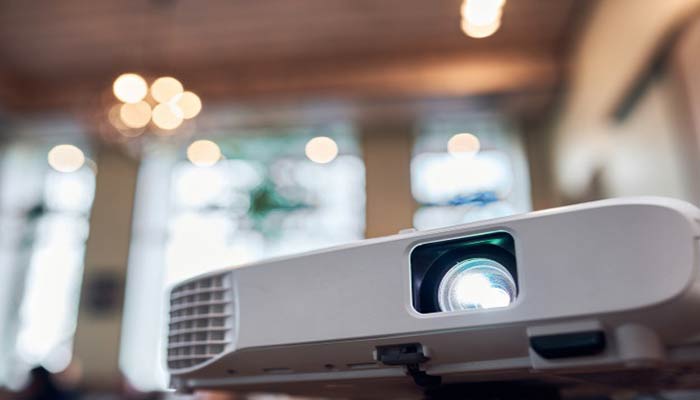Table of Contents
If you want sound coming from your computer to your projector, you need a way to connect the two. One cable can do the job, but there are others options some people prefer. Let’s take a look at some of those other connections and their benefits and drawbacks.
Easy Ways to Connect Computer to Projector to get the Sound
USB Connection
This option is the simplest of them all because it gets power and sound over one cable. The downside here is that it only works with newer computers, likely those released in the last few years. Older computers need a certain type of driver to work with the sound.
DisplayPort Connection
This audio-visual interface uses DisplayPort technology. It produces better sound and allows for audio-only or dual video applications in a single cable. Of course, you’ll need a display with that port to make it work, and, as with USB, it only works with newer computers—older computers are not supported.
HDMI Connection
This is HDCP-compliant and permits audio and video communication over one cable. It’s compatible with older computers but not new ones. It also only works with newer displays, so you’ll need one of those.
Audio-Only Connections
The most common way to connect audio to a projector is by using a 3.5mm jack that plugs into your computer’s sound card. This is particularly useful if you don’t want or can’t use the other options because it is simple, quick, relatively inexpensive, and works well for many computers. Just remember that some older electronics don’t support it, so you may need a special adapter. Using this kind of connection will also give you the best sound quality.
Optical Audio
This is a popular connection because it works with any computer and does not need external power. It’s simple to use and delivers good sound, but it can only handle 2 channels at a time, instead of the 7.1 needed for HD sound.
RJ14 Phone Jack
This type of jack is used on many older computers and in some more high-end projectors to provide audio support for your video needs. It works with the computer’s sound card, and it’s relatively straightforward to use.
Which Connection to Use?
If you want the sound to come from your computer while you’re using it, your best bet is the USB connection. It may not work with older computers, but that’s not usually an issue.
You can always connect additional speakers if you need sound for a video or presentation but don’t have the money for newer equipment. If you want separate audio and video signals, there are many options to choose from, so be sure to understand what you need before making a decision.
Are all Projectors Soundless?
Video projectors come in many shapes and sizes. They are often used to watch video clips, films, videos, and presentations in schools and colleges. But are all video projectors soundless? No, they aren’t! While the majority of today’s projectors are silent, a few models produce sound as well.
Most Projectors are Silent
The majority of video projectors don’t produce any noise at all since their light source (e.g., laser) is usually completely silent or mechanically driven rather than electrically powered and doesn’t involve any moving parts or hot lamps like before that emit noise when turned on.
The optical engine or light source inside the projector is typically installed onto a metal chassis. But there are silent versions of projectors with electric light sources too, which though relatively more expensive than the laser-driven ones, are mostly found in home theaters these days.
Some video projectors also have a built-in speaker inside for listening to the sound from the source connected to them. These projectors are specially designed to be used in places with no audio systems or they are portable and plug into any television for projection.
Projectors with Built-In Speakers
Many manufacturers, as well as dealers, sell projectors that are combined with speakers so that you don’t need an external device like a sound system or TV for listening to the audio. These models are called television-like projector and mostly come in compact sizes, easy to carry around, and can be plugged into any TV for projection purposes. They are usually more affordable than the standard projectors and can be used in classrooms, lecture halls, and meeting rooms.
Projectors with their Own Sound
There are also some projectors that produce sound as well. These portable models can be connected to a laptop or computer and are mostly designed for business use. The video projector has an inbuilt speaker to produce sound instead of using an external audio system or TV.
Projector with Built-in Speakers are Not Recommended
Having speakers inside a projector may seem convenient, but buying a unit with built-in speakers isn’t recommended at all unless you need a portable unit for your bedroom, kitchen, or office where there is no television or other audio system.
The speakers inside the projector are not designed as high-fidelity sound systems. Most of them are somehow tinny and don’t produce a strong base.
Related Articles:



